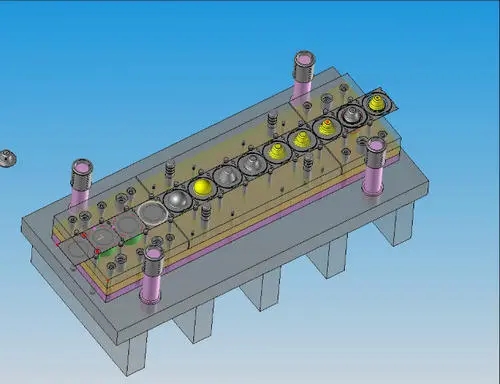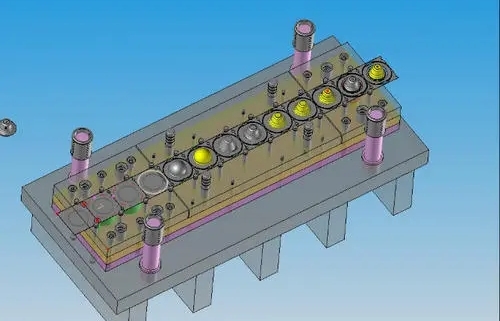Multi-station progressive die
Multi-station progressive die
Overview of multi station progressive dies

1. The multi-station progressive dies is a precision, high-efficiency, long-life precision die with high production efficiency, reliable quality, safe operation, saving molds, machine tools and labor, and good economic benefits.
2. According to the nature of the stamping process: punching multi-station progressive dies, forming process multi-station progressive dies (with bending, stretching, forming and other processes).
3. According to the design layout method, it is divided into: closed-hole continuous progressive die, segmented cutting multi-stage progressive die.
4. Combine the above two methods and use them flexibly.
Conditions for using multi station progressive die
Although the multi-station progressive dies has many advantages, its structure is complex, the manufacturing technology requirements are high, and it is also limited by presses, sheet materials, and production batches.
Mold repair ability and stamping equipment:
-Must have a qualified multi-station progressive dies
-Must have the technical ability to adjust, repair, maintain, and sharpen repair
-Must have the ability to meet the multi-station progressive dies Stamping equipment required for continuous stamping production
1) Compared with ordinary presses, this kind of stamping equipment requires better accuracy and rigidity, larger power, punching times, and table size, and the brake system is reliable and stable; it should also have adjustable stroke to facilitate progressive die Debugging.
2) The precision and sensitivity of the feeding mechanism is high.
Requirements for the processed materials:
1) The materials used should be stable and high-quality, mainly referring to the grades and mechanical properties of the materials. Each batch of materials should be consistent and meet the technical conditions specified for the material. The soft and hard materials meet the requirements for use. The thickness and width dimensions should be within the specified tolerance range, and the surface condition is good. Therefore, the material must meet the design requirements of stamping parts, and the physical and mechanical properties should be stable.
2) Multi station progressive die stamping materials are mostly long strips.
The punched parts should conform to the multi-station progressive die punching system:
1) The product should be a stereotyped product, and the production batch should be large enough, otherwise the economic benefits will be poor.
2) The strip is sufficiently rigid.
3) Punching parts are not suitable for single-process die punching.
4) The punching parts are not suitable for punching with composite molds.
5) The length and thickness of the stamping materials are more appropriate.
6) The feeding error and the accumulated error between each process step should not reduce the accuracy of the parts.
7) The punching parts with complex shapes should be completed in a multi station progressive die as much as possible.
8) The two stamping parts on the same product have a mutual size relationship, and even when there is a matching relationship, they can be combined in a multi station progressive die to complete the punching, which can improve the material utilization rate.
9) Large production batches.



